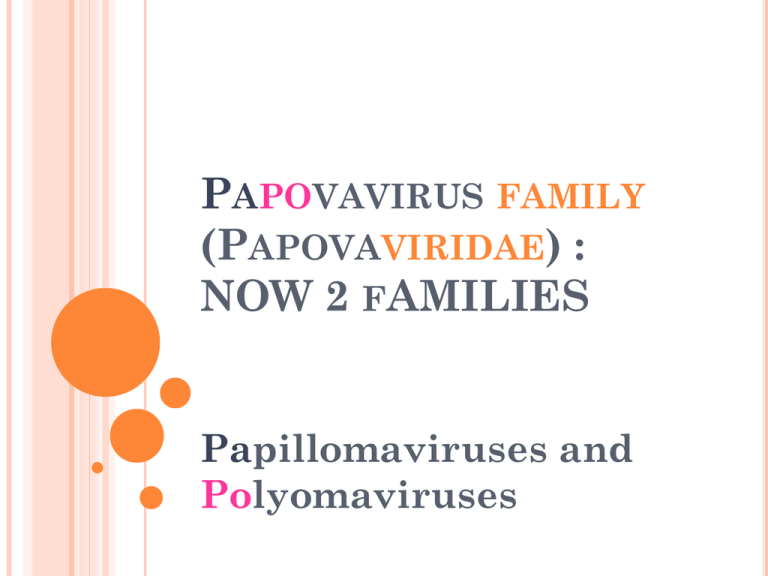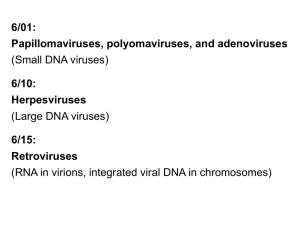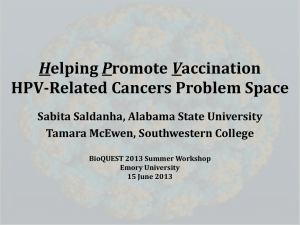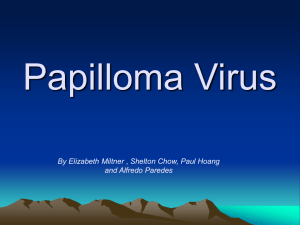papovavirus family (Papovaviridae)
advertisement

PAPOVAVIRUS FAMILY (PAPOVAVIRIDAE) : NOW 2 FAMILIES Papillomaviruses and Polyomaviruses HUMAN PAPILLOMAVIRUSES (HPVS): Warts human cancer (e.g., cervical carcinoma): several genotypes POLYOMAVIRIDAE BK and JC viruses, usually asymptomatic infection in immunosuppressed people : BK: renal disease JC: progressive multifocal leukoencephalopathy (PML), Simian virus 40 (SV40) UNIQUE PROPERTIES OF POLYOMAVIRUSES AND PAPILLOMAVIRUSES Small Double-stranded genome circular DNA UNIQUE PROPERTIES OF POLYOMAVIRUSES AND PAPILLOMAVIRUSES Viruses encode proteins that promote cell growth These proteins bind to the cellular growth-suppressor proteins p53 and p105RB (p105 retinoblastoma gene product). Papilloma E6 binds to p53, and Papilloma E7 binds to p105RB UNIQUE PROPERTIES OF POLYOMAVIRUSES AND PAPILLOMAVIRUSES lytic infections Persistent latent infections immortalize (transform) cells HUMAN PAPILLOMAVIRUSES (HPV) More than 100 genotypes HPV can be distinguished further as cutaneous HPV or mucosal HPV on the basis of the susceptible tissue. Within the mucosal HPV, there is a group associated with cervical cancer. HPV infect and replicate in the squamous epithelium of skin (warts) and mucous membranes (genital, oral, and conjunctival papillomas) to induce epithelial proliferation. TRANSMISSION HPV resists inactivation can be transmitted on fomites, such as the surfaces of countertops or furniture, bathroom floors, and towels Asymptomatic shedding may promote transmission. TRANSMISSION HPV (1) (2) (3) infection is acquired by direct contact through small breaks in the skin or mucosa during sexual intercourse while an infant is passing through an infected birth canal. DISEASE MECHANISMS OF PAPILLOMAVIRUSES AND POLYOMAVIRUSES PAPILLOMAVIRUSES Virus is acquired by close contact and infects the epithelial cells of the skin or mucous membranes. Tissue tropism and disease presentation depend on the papillomavirus type. Virus persists in the basal layer and then produces virus in terminally differentiated keratinocytes. Viruses cause benign outgrowth of cells into warts. DISEASE MECHANISMS OF PAPILLOMAVIRUSES AND POLYOMAVIRUSES PAPILLOMAVIRUSES HPV infection is hidden from immune responses and persists. Warts resolve spontaneously, possibly as a result of immune response. Certain types are associated with dysplasia that may become cancerous with the action of cofactors. DNA of specific HPV types is present (integrated) in the tumor cell chromosomes. POLYOMAVIRUSES (JC AND BK VIRUSES) Virus is probably acquired through the respiratory route and spread by viremia to the kidneys early in life. Infections Virus are asymptomatic. establishes persistent and latent infection in organs such as the kidneys and lungs. POLYOMAVIRUSES (JC AND BK VIRUSES) In immunocompromised people, BK: Renal infection(hematuri) JC virus is activated, spreads to the brain, and causes progressive multifocal leukoencephalopathy (PML), a conventional slow virus disease. EPIDEMIOLOGY OF POLYOMAVIRUSES AND PAPILLOMAVIRUSES Disease/Viral Factors Capsid virus is resistant to inactivation Virus persists in host Asymptomatic shedding is likely Transmission Papillomavirus: direct contact, sexual contact (sexually transmitted disease) for certain virus types, or passage through infected birth canal for laryngeal papillomas (types 6 and 11) Polyomavirus: inhalation or contact with contaminated water EPIDEMIOLOGY OF POLYOMAVIRUSES AND PAPILLOMAVIRUSES Who Is at Risk? Papillomavirus: warts are common; sexually active people are at risk for infection with HPV types correlated with oral and genital cancers Polyomavirus: ubiquitous; immunocompromised people HUMAN PAPILLOMAVIRUS is possibly the most prevalent sexually transmitted infection in the world, with certain HPV types common among sexually active people. At least 20 million people in the United States are infected with HPV, with approximately 6 million new genital cases per year. HPV HPV is present in 99.7% of all cervical cancers. HPV-16, HPV-18, HPV-31, and HPV-45 are high-risk the second leading cause of cancer death in women HPV 10% of women infected with the high-risk HPV types will develop cervical dysplasia, a precancerous state. Major risk factors for infection and progression to cancer: Multiple sexual partners smoking a family history of cervical cancer immunosuppression HPV DISEASES Cutaneous Skin Syndromes warts Mucosal Syndromes Benign head and neck tumors Laryngeal papilloma Oral papilloma Conjunctival papilloma Anogenital warts Condyloma acuminatum 6, 11 Cervical intraepithelial neoplasia, cancer16, 18 Downloaded from: StudentConsult (on 11 May 2009 01:13 PM) © 2005 Elsevier Downloaded from: StudentConsult (on 11 May 2009 01:13 PM) © 2005 Elsevier Downloaded from: StudentConsult (on 11 May 2009 01:13 PM) © 2005 Elsevier Downloaded from: StudentConsult (on 11 May 2009 01:13 PM) © 2005 Elsevier LABORATORY DIAGNOSIS OF PAPILLOMAVIRUS INFECTIONS Cytology:PAP smear:Koilocytotic cells Polymerase chain reaction Viral nucleic acid KOILOCYTES characteristic of papillomavirus infection, are enlarged keratinocytes with clear haloes around shrunken nuclei Downloaded from: StudentConsult (on 11 May 2009 01:13 PM) © 2005 Elsevier VACCINE: Vaccine: http://www.cdc.gov/hpv/ tetravalent HPV vaccine (Gardasil) :HPV 6, 11, 16, and 18 can prevent infection and hence reduce the incidence of anogenital warts and cervical cancer. Bivalent HPV(Cervarix)(16,18) A series of three immunizations is recommended for girls ( boys), starting at age 11 prior to sexual activity. VACCINE The HPV vaccine is not a replacement for a PAP smear, and women should continue to be tested. At present, the best way to prevent transmission of warts is to avoid coming in direct contact with infected tissue. Proper precautions (e.g., the use of condoms) can prevent the sexual transmission of HPV!!!!







